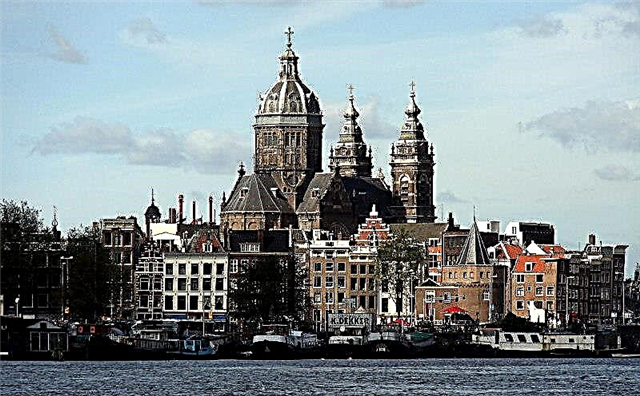Address: Russia, Saint Petersburg, Peter and Paul Fortress
Building: 1712 - 1733 years
Architect: Domenico Trezzini
Height: 122.5 m
Coordinates: 59 ° 57'00.7 "N 30 ° 18'59.4" E
Cultural heritage site of the Russian Federation
Content:
On the Hare Island, in the center of the famous Peter and Paul Fortress, an unusual temple rises. Emperors, from Peter I to Nicholas II, rest under the arches of the Orthodox cathedral. The Tsar's necropolis and other relics attract tourists like a magnet, so there are many travelers from different cities of Russia and from abroad in the cathedral.

General view of the Peter and Paul Cathedral
How the cathedral was built
The construction of the temple began simultaneously with the city - in the summer of 1703. The first cathedral was built of wood and consecrated in 1704. The stone building was laid in May 1712 and completed after the death of Peter I, in 1733.
The new cathedral was not like other churches in St. Petersburg. The emperor wanted to see a Western European temple in the northern capital, so the church on the Hare Island was erected according to the canons of European temple architecture. The project for the building in the Petrine Baroque style was prepared by the famous Italian architect Dominica Trezzini. It is noteworthy that the first wooden church was not demolished, but surrounded by stone walls.
The history of the temple in the XVIII-XX centuries
Until the middle of the 19th century, the Peter and Paul Cathedral served as a cathedral church, and then it was assigned to the court department. The sacraments of weddings and baptisms have never been performed here. Under the vaults of the cathedral, funeral services were held for members of the Russian ruling family and representatives of princely families close to the imperial house.

Peter and Paul Cathedral in the night illumination
The kings and their closest relatives lie in the church itself and in the Grand Duke's tomb in stone coffins. When the commandants of the fortress died, they were also buried in the royal church and buried as honorary citizens of the city.
The old cathedral has been reconstructed and repaired many times. The first time this happened in the middle of the 18th century after a big fire. In 1776, a tower clock appeared on the bell tower, made by the Dutch master B. Oort Kras.
In 1777, the city suffered from a devastating storm. Strong gusts of wind damaged the high spire, and the architect Petr Paton restored it. Another architect Antonio Rinaldi decorated the top of the spire with a huge figure of an angel with a cross. The weather vane 3.2 m high and weighing 250 kg obediently rotated and indicated where the wind was blowing.
In 1830, during a thunderstorm, the angel was damaged. To repair the weather vane, an experienced roofer Pyotr Telushkin climbed the spire without scaffolding and eliminated the malfunction. For excellent work, the tsar allowed the master to visit any drinking establishments in Russia free of charge. How the future fate of the roofer developed is not known.

Peter and Paul Cathedral at night
In the 1850s, the dilapidated wooden structures of the spire were replaced with metal ones. The technically challenging work was supervised by architect Konstantin Ton and mechanical engineers Dmitry Zhuravsky, Pavel Melnikov and Alexander Rekhnevsky. Interestingly, after the reconstruction, the building grew from 112 m to 122.5 m.
Soon after the revolution, in 1919, the temple was closed to believers and a few years later turned into a museum. At the same time, many old icons, liturgical utensils and vestments were added to other museum depositories.
During the Great Patriotic War, German troops repeatedly shelled and bombed Leningrad. The old cathedral was badly destroyed by explosions, and its restoration took several years. In 1954, the completely restored temple was transferred to the jurisdiction of the Museum of the History of the City.
Architectural features
The cathedral does not look like Orthodox churches typical of pre-Petrine Russia. The building measures 61 meters by 27.5 meters and stretches from west to east. Its dome is crowned by a narrow spire with a height of 122.5 m. For three hundred years, the main temple of the fortress was the tallest building in the city and emphasized the role of the kings in governing the great country.

View of the Peter and Paul Cathedral from the Cathedral Square of the Peter and Paul Fortress
The facade of the cathedral is decorated in a strict European style. There is no excess of gold and bright colors typical for old Russian churches. The decor is very modest. The temple is decorated only with flat pillars-pilasters and heads of cherubs on the windows. Despite the severity, the church looks light and upward.
In the eastern part of the building, you can see a fresco by the artist Titov, which depicts the apostles Peter and Paul standing in front of Jesus Christ. In the west, from the side of the bell tower, the two-tier facade is decorated with pilasters. The third tier is completed by an expressive eight-pitched roof, and above it there is an octagonal drum.
A golden crown flaunts at the very top, and a narrow spire rises to a height of 40 m. The bell tower building is a noticeable landmark in the city; it can be seen from different districts of St. Petersburg.
Interiors
The rich three-nave temple resembles a luxurious ceremonial hall. Strong marble columns support the vaults. The floor is made of limestone slabs, and the interiors are decorated with pink rhodonite, multi-colored marble and ornamental jasper. The walls were decorated by the artists Nygrubov and Vorobyov, and the exquisite stucco molding was done by the Italian masters Antonio Quadri and Ignazio Rossi.

Bell tower of the Peter and Paul Cathedral
Five large chandeliers fill the interior spaces with even light. The lamps are made of gilded bronze, rock crystal and Venetian glass. The original chandelier of the 18th century hangs in front of the altar, while the other four are copies that were restored in the post-war period.
Everyone who finds themselves in the cathedral is struck by the huge iconostasis 20 m high. It was carved in the 1720s according to the drawing of Dominico Trezzini by the masters of the Moscow Kremlin's Armory. More than 40 icons of the middle of the 18th century are installed in the icon cases of the altar. The Royal Doors are surrounded by the figures of the archangels Gabriel and Michael, and next to it there is a gilded pulpit for sermons.
For many years the cathedral served as a monument to Russian weapons. For about two centuries, captured standards and keys to cities that were captured by Russian troops were kept here. At the beginning of the last century, almost all historical values were transferred to the Hermitage. Today, only the banners of the Swedish and Turkish armies are displayed in the temple.
More than a hundred bells hang on the bell tower and a carillon is installed - a musical mechanism that came to Russia under Peter I. From time to time, concerts of carillon music are held in the fortress.

View of the southern facade of the Peter and Paul Cathedral
The most famous burial sites
Who is buried in the Peter and Paul Cathedral? Several generations of the royal family lie in the ancient temple. Emperor Peter I was buried in the crypt, which stands in the chapel of St. Catherine. Next to him lie Nicholas II, buried in 1998, and members of his family, along with a servant - a footman, a maid, a cook and a physician.
To the right of the iconostasis, next to Peter I, rest his wife Catherine I, daughter Elizabeth Petrovna, Empress Anna Ioannovna, Catherine II and Tsar Peter III. To the left of the altar are the sarcophagi of the emperors Paul I, Alexander I and Nicholas I.
The Grand Duke's tomb is connected to the cathedral by a special passage. It appeared at the beginning of the 20th century, since there was not enough space for burials in the temple itself. Now there are sarcophagi of the same type made of white marble with bronze crosses. Only the crypts of Emperor Alexander II and his wife Maria Alexandrovna, made of pink eagle and green jasper, stand out.

From left to right: Peter and Paul Cathedral, Grand Duke's tomb
During the years of Soviet power, the interior of the tomb was completely destroyed, and a beautiful stained-glass altar window was knocked out by a blast wave during the war. The complete restoration of the architectural and historical monument was completed in the 21st century. Since 2016, the tomb has been open to tourists.
The last one who was buried in the cathedral was the mother of the Russian Tsar Nicholas II - Empress Maria Feodorovna. Her ashes were brought to our country from Denmark, where she died in 1928.
Since 1990, the temple has hosted regular memorial services dedicated to the memory of the Russian emperors. And since 2000, daily and festive church services have been held here.
Useful information for visitors
The temple and tomb are open on weekdays from 10:00 to 19:00, on Saturday from 10:00 to 17:45, and on Sunday from 11:00 to 17:45. A ticket for adults costs 450 rubles, for students - 250 rubles, and for pensioners - 200 rubles.

Interior of the Peter and Paul Cathedral
In the cathedral you can see the burials of kings, beautiful stucco moldings, military relics and paintings. The guides tell interesting stories about the role of the imperial family in the history of Russia.
How to get there
It is convenient to walk to the temple from the Gorkovskaya metro station. The path lies through Aleksandrovsky Park and Kronverkskaya Embankment.











